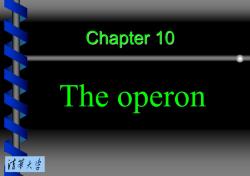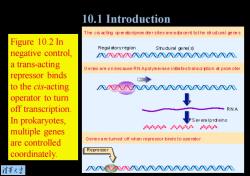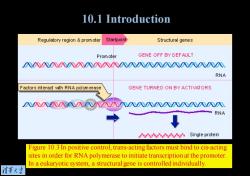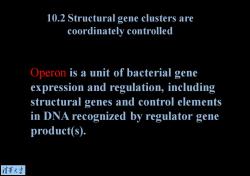清华大学:《分子生物学》课程PPT教学课件(基因ene)第十章 操纵子(The operon)

Chapter 10 The operon 清革大当
Chapter 10 The operon

10.1 Introduction 10.2 Regulation can be negative or positive 10.3 Structural gene clusters are coordinately controlled 10.4 The lac genes are controlled by a repressor 10.5 The lac operon can be induced 10.6 Repressor is controlled by a small molecule inducer 10.7 cis-acting constitutive mutations identify the operator 10.8 trans-acting mutations identify the regulator gene 10.9 Multimeric proteins have special genetic properties 10.10 Repressor protein binds to the operator 10.11 Binding of inducer releases repressor from the operator 10.12 Repressor is a tetramer 10.13 Repressor binds to three operators and interacts with RNA polymerase 10.14 Repressor is always bound to DNA 10.15 The operator competes with low-affinity sites to bind repressor 10.16 Repression can occur at multiple loci 情莘大当
10.1 Introduction 10.2 Regulation can be negative or positive 10.3 Structural gene clusters are coordinately controlled 10.4 The lac genes are controlled by a repressor 10.5 The lac operon can be induced 10.6 Repressor is controlled by a small molecule inducer 10.7 cis-acting constitutive mutations identify the operator 10.8 trans-acting mutations identify the regulator gene 10.9 Multimeric proteins have special genetic properties 10.10 Repressor protein binds to the operator 10.11 Binding of inducer releases repressor from the operator 10.12 Repressor is a tetramer 10.13 Repressor binds to three operators and interacts with RNA polymerase 10.14 Repressor is always bound to DNA 10.15 The operator competes with low-affinity sites to bind repressor 10.16 Repression can occur at multiple loci

10.17 Distinguishing positive and negative control 10.18 Catabolite repression involves the inducer cyclic AMP and the activator CAP 10.19 CAP functions in different ways in different target operons 10.20 CAP bends DNA 10.21 The stringent response produces(p)ppGpp 10.22(p)ppGpp is produced by the ribosome 10.23 pGpp has many effects 10.24 Translation can be regulated 10.25 r-protein synthesis is controlled by autogeneous regulation 10.26 Phage T4 p32 is controlled by an autogenous circuit 10.27 Autogenousregulation is often used to control synthesis of macromolecular assemblies 10.28 Alternative secondary structures control attenuation 10.29 The tryptophan operon is controlled by attenuation 10.30 Attenuation can be controlled by translation 10.31 Small RNA molecules can regulate translation 10.32 Antisense RNA can be used to inactivate gene expression 清苇大当
10.17 Distinguishing positive and negative control 10.18 Catabolite repression involves the inducer cyclic AMP and the activator CAP 10.19 CAP functions in different ways in different target operons 10.20 CAP bends DNA 10.21 The stringent response produces (p)ppGpp 10.22 (p)ppGpp is produced by the ribosome 10.23 pGpp has many effects 10.24 Translation can be regulated 10.25 r-protein synthesis is controlled by autogeneous regulation 10.26 Phage T4 p32 is controlled by an autogenous circuit 10.27 Autogenous regulation is often used to control synthesis of macromolecular assemblies 10.28 Alternative secondary structures control attenuation 10.29 The tryptophan operon is controlled by attenuation 10.30 Attenuation can be controlled by translation 10.31 Small RNA molecules can regulate translation 10.32 Antisense RNA can be used to inactivate gene expression

10.1 Introduction Operator is the site on DNA at which a repressor protein binds to prevent transcription from initiating at the adjacent promoter. Repressor protein binds to operator on DNA or RNA to prevent transcription or translation,respectively. Structural gene codes for any RNA or protein product other than a regulator. 情苇大兰
Operator is the site on DNA at which a repressor protein binds to prevent transcription from initiating at the adjacent promoter. Repressor protein binds to operator on DNA or RNA to prevent transcription or translation, respectively. Structural gene codes for any RNA or protein product other than a regulator. 10.1 Introduction

10.1 Introduction Reg ul ator protein Figure 10.1 A regulator gene mRNA codes for a protein that acts at a target site on DNA Re gulator gene la rget site 清第大当
Figure 10.1 A regulator gene codes for a protein that acts at a target site on DNA. 10.1 Introduction

10.1 Introduction The cis acting cp er ato riprom dter sites are adacent tothe str ud ural genes Figure 10.2 In Regul atory region Strudural gene(s) negative control, N入入入八N八N八N八NNN八N a trans-acting Genes are on because RN Apolymerase initiatestranscr iption at prom oter repressor binds to the cis-acting NN入入NNN八LZ00020风N operator to turn off transcription RNA In prokaryotes, Sev eralprdeins multiple genes are controlled Genes are tumed off when repressor binds to ope rator Repressor coordinately. 清菜大当 八NN风N凡N八LZ02020020八
Figure 10.2 In negative control, a trans-acting repressor binds to the cis-acting operator to turn off transcription. In prokaryotes, multiple genes are controlled coordinately. 10.1 Introduction

10.1 Introduction Regulatory region prom oter Startpoint Structural genes Prom oter GENE OFF BY DEFAULT N八N八N八N八NNN八N风NN风NN RNA Factors interac with RNA polym erase GENE TURNED ON BY ACTIVATORS 八八入N八风入风风风风风风风风风风风风 RNA Single protein Figure 10.3 In positive control,trans-acting factors must bind to cis-acting sites in order for RNA polymerase to initiate transcription at the promoter. In a eukaryotic system,a structural gene is controlled individually 清萃大兰
Figure 10.3 In positive control, trans-acting factors must bind to cis-acting sites in order for RNA polymerase to initiate transcription at the promoter. In a eukaryotic system, a structural gene is controlled individually. 10.1 Introduction

10.2 Structural gene clusters are coordinately controlled Operon is a unit of bacterial gene expression and regulation,including structural genes and control elements in DNA recognized by regulator gene product(s). 情華大当
Operon is a unit of bacterial gene expression and regulation, including structural genes and control elements in DNA recognized by regulator gene product(s). 10.2 Structural gene clusters are coordinately controlled

10.2 Structural gene clusters are coordinately controlled 公X入NN苏NNN P 1040 82 3510 780 825 mRNA Protein Repressor B-galactosidase P ermeaseTransacetyase Figure 10.4 The lac operon occupies ~6000 bp of DNA.At the left the lacl gene has its own promoter and terminator.The end of the lacl region is adjacent to the promoter,P.The operator,O, occupies the first 26 bp of the long lacZ gene,followed by the 清菜大当 lacY and lac4 genes and a terminator
Figure 10.4 The lac operon occupies ~6000 bp of DNA. At the left the lacI gene has its own promoter and terminator. The end of the lacI region is adjacent to the promoter, P. The operator, O, occupies the first 26 bp of the long lacZ gene, followed by the lacY and lacA genes and a terminator. 10.2 Structural gene clusters are coordinately controlled

10.2 Structural gene clusters are coordinately controlled Startpoint Figure 10.5 Repressor and RNA polymerase -50-40-30-20-1011020 30 bind at sites that Promater overlap around binds RNA polymerase the startpoint of Operator the lac operon. binds repressor 清菜大当
Figure 10.5 Repressor and RNA polymerase bind at sites that overlap around the startpoint of the lac operon. 10.2 Structural gene clusters are coordinately controlled
按次数下载不扣除下载券;
注册用户24小时内重复下载只扣除一次;
顺序:VIP每日次数-->可用次数-->下载券;
- 清华大学:《分子生物学》课程PPT教学课件(基因ene)第九章 转录(Transcription).ppt
- 清华大学:《分子生物学》课程PPT教学课件(基因ene)第八章 蛋白质定位(Protein localization).ppt
- 清华大学:《分子生物学》课程PPT教学课件(基因ene)第七章 遗传密码的利用(Using the genetic code).ppt
- 清华大学:《分子生物学》课程PPT教学课件(基因ene)第六章 蛋白质合成(Protein synthesis).ppt
- 清华大学:《分子生物学》课程PPT教学课件(基因ene)第五章 信使RNA(Messenger RNA).ppt
- 清华大学:《分子生物学》课程PPT教学课件(基因ene)第四章 簇和重复(Clusters and repeats).ppt
- 清华大学:《分子生物学》课程PPT教学课件(基因ene)第三章 有多少基因(How many genes are there).ppt
- 清华大学:《分子生物学》课程PPT教学课件(基因ene)第二章 从基因到基因组(From Genes to Genomes).ppt
- 清华大学:《分子生物学》课程PPT教学课件(基因ene)第一章 基因是DNA(Genes are DNA).ppt
- 清华大学:《分子生物学》课程PPT教学课件(基因ene)绪论 Molecular Biology(主讲:王钊).ppt
- 河北农业大学:《分子生物学》课程教学资源(PPT课件)第十二章 免疫多样性产生的机制.ppt
- 河北农业大学:《分子生物学》课程教学资源(PPT课件)第十一章 病毒的分子生物学.ppt
- 河北农业大学:《分子生物学》课程教学资源(PPT课件)第十章 遗传重组.ppt
- 河北农业大学:《分子生物学》课程教学资源(PPT课件)第九章 真核生物基因表达调控.ppt
- 河北农业大学:《分子生物学》课程教学资源(PPT课件)第八章 原核生物基因表达调控.ppt
- 河北农业大学:《分子生物学》课程教学资源(PPT课件)第七章 蛋白质翻译(Protein Translation).ppt
- 河北农业大学:《分子生物学》课程教学资源(PPT课件)第六章 RNA转录(RNA transcription).ppt
- 河北农业大学:《分子生物学》课程教学资源(PPT课件)第五章 DNA损伤、修复和突变.ppt
- 河北农业大学:《分子生物学》课程教学资源(PPT课件)第四章 DNA复制(DNA Replication).ppt
- 河北农业大学:《分子生物学》课程教学资源(PPT课件)第三章 有机体、染色体和基因.ppt
- 清华大学:《分子生物学》课程PPT教学课件(基因ene)第十一章 噬菌体的战略(Phage strategies).ppt
- 清华大学:《分子生物学》课程PPT教学课件(基因ene)第十二章 复制子(The replicon).ppt
- 清华大学:《分子生物学》课程PPT教学课件(基因ene)第十三章 DNA复制(DNA replication).ppt
- 清华大学:《分子生物学》课程PPT教学课件(基因ene)第十四章 重组和修复(Recombination and repair).ppt
- 清华大学:《分子生物学》课程PPT教学课件(基因ene)第十五章 转座子(Transposons).ppt
- 清华大学:《分子生物学》课程PPT教学课件(基因ene)第十六章 逆转录病毒和逆转座子(Retroviruses and retroposons).ppt
- 清华大学:《分子生物学》课程PPT教学课件(基因ene)第十七章 DNA的重新排列(Rearrangement of DNA).ppt
- 清华大学:《分子生物学》课程PPT教学课件(基因ene)第十八章 染色体(Chromosomes).ppt
- 清华大学:《分子生物学》课程PPT教学课件(基因ene)第十九章 核小体(Nucleosomes).ppt
- 清华大学:《分子生物学》课程PPT教学课件(基因ene)第二十章 转录的起始(Initiation of transcription).ppt
- 清华大学:《分子生物学》课程PPT教学课件(基因ene)第二十一章 转录的调控(Regulation of Transcription).ppt
- 清华大学:《分子生物学》课程PPT教学课件(基因ene)第二十二章 核的剪切(Nuclear splicing).ppt
- 清华大学:《分子生物学》课程PPT教学课件(基因ene)第二十三章 催化RNA(Catalytic RNA).ppt
- 清华大学:《分子生物学》课程PPT教学课件(基因ene)第二十四章 免疫多样性(Immune diversity).ppt
- 清华大学:《分子生物学》课程PPT教学课件(基因ene)第二十五章 蛋白质间的开放交通(Protein trafficking).ppt
- 清华大学:《分子生物学》课程PPT教学课件(基因ene)第二十六章 信号的传输(Signal transduction).ppt
- 清华大学:《分子生物学》课程PPT教学课件(基因ene)第二十七章 细胞循环和生长调控(Cell cycle and growth regulation).ppt
- 清华大学:《分子生物学》课程PPT教学课件(基因ene)第二十八章 致癌基因和癌症(Oncogenes and cancer).ppt
- 清华大学:《分子生物学》课程PPT教学课件(基因ene)第二十九章 梯度、级联和发信号的途径(Gradients, cascades, and signaling pathways).ppt
- 四川大学:《植物生物学》课程教学资源(教案讲义)第一章 植物的细胞和组织.pdf
